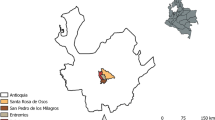Summary
Sera from 1,700 beef and dairy cattle in Israel were tested for besnoitiosis by indirect immunofluorescence. Over 90% of dairy animals were negative whereas about 50% of beef cattle were positive. Among beef bulls the percentage of positive reactors increased with age but in beef cows the pattern was less clear; 36% of young imported bulls negative upon arrival developed antibody titres after one season on the range. Cross-tests withToxoplasma gondii antiserum and antigen indicated that the results of the survey for besnoitiosis were unlikely to have been influenced byToxoplasma antibodies.
Résumé
Les sérums de 1700 bovins laitiers et de boucherie ont été examines par immunofluorescence indirecte pour déceler la besnoitiose. Plus de 90 p. 100 des bovins laitiers étaient négatifs alors que 50 p. 100 des bovins de boucherie étaient positifs. Parmi les taureaux de boucherie, le pourcentage d'animaux réagissant positivement augmentait avec l'âge mais, chez les vaches, le tableau était moins clair. 36 p. 100 des taurillons importés, négatifs à leur arrivée, ont produit des anticorps après une saison passée au pâturage. Des épreuves croisées avec antigène et anti sérum deToxoplasma gondii ont indiqué que les resultats de l'enquête sur la besnoitiose avaient probablement été influencés par des anticrops deToxoplasma gondii.
Resumen
Se utilizó la prueba de inmunofluorescencia indirecta para analizar 1.700 sueros para detectar besnoitiosis. Las muestras se colectaron tanto de ganado para la producción de leche como de carne. Más del 90% del ganado destinado a la producción de leche fué negativo; mientras que aproximadamente el 50% del ganado para carne fué positivo. Entre los reproductores para la producción de carne, el porcentaje de positivos se incrementó con la edad. En las vacas el patrón fué menos claro; 36% de los toros jovenes importados negativos, desarrollaron anticuerpos despues de una estación en pastoreo. Pruebas cruzadas con antígenos y antisueros deToxoplasma gondii demonstraron que los resultados primarios no fueron influenciados por anticuerpos de toxoplasmosis.
Similar content being viewed by others
References
Campana-Rouget, Y., Levitte, F. &Assman, A. M. (1974).Parasitic Zoonoses, (Ed. E. J. I. Soulsby), Academic Press, New York, pp. 27–33.
Frank, M., Pipano, E. &Rosenberg, A. (1977).Refuah Veterinarit,34, 83–86.
Goldman, M. (1968).Fluorescent Antibody Methods, Academic Press, New York, p. 148.
Hofmeyr, C. F. B. (1945).Journal of the South African Veterinary Medical Association,16, 102–109.
Lunde, M. N. &Jacobs, L. (1965).Journal of Parasitology,51, 273–276.
Neuman, M. (1972).Zentralblatt für Veterinarmedizin, B,19, 394–396.
Neuman, M. &Nobel, T. A. (1960).Refuah Veterinarit,17, 100–102.
Nobel, T. A., Neuman, M., Klopfer, U. &Perl, S. (1977).Bulletin de l'Académie vétérinaire de France,50, 569–574.
Suggs, M. T., Walls, K. W. &Kagan, I. G. (1968).Journal of Immunology,101, 166–175.
Author information
Authors and Affiliations
Rights and permissions
About this article
Cite this article
Goldman, M., Pipano, E. Serological studies on bovine besnoitiosis in Israel. Trop Anim Health Prod 15, 32–38 (1983). https://doi.org/10.1007/BF02250758
Accepted:
Issue Date:
DOI: https://doi.org/10.1007/BF02250758



